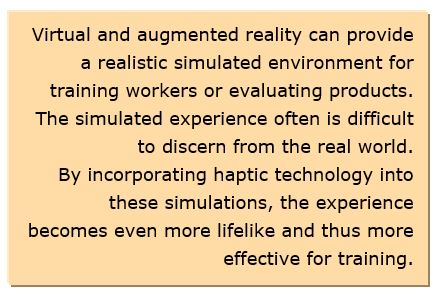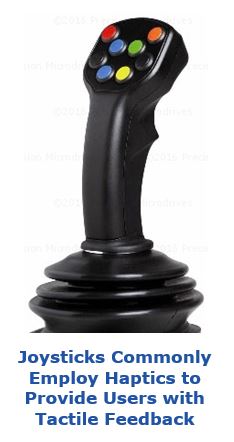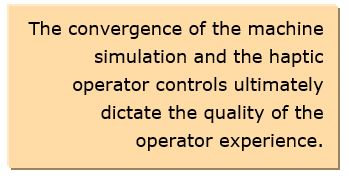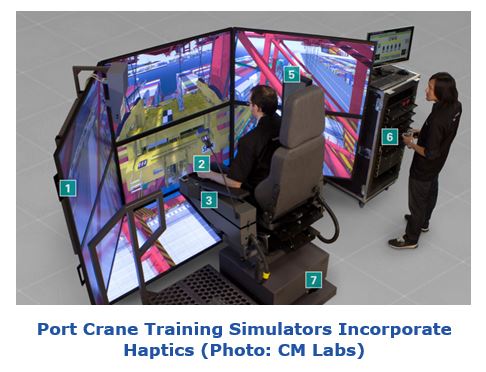


Virtual and augmented reality can provide a realistic simulated environment that often is difficult to discern from the real world. By incorporating haptic technology to recreate the sense of touch for users through force, vibration, or motion; the experience becomes even more lifelike and thus more effective for training purposes.
Today, by using a systematic approach to combine virtual and augmented reality, companies can create a safe, but highly realistic simulated environment in which to train employees and/or test new products.
Training simulators that incorporate virtual reality are based on 3D digital models of physical environments. These models can provide the user with a perspective of the virtual models based on real-world limitations. Along with the visual experience that incorporates the physics of the actual system, simulators often add sound to further engage the user’s senses.
Augmented reality, in turn, superimposes additional information onto a real image. In the simplest case, we experience augmented reality during live televised sporting events. For example, in the US, when virtual grids are overlaid on the televised football fields to display first down markers or the trajectory of field goal attempts.
The addition of haptics technology to recreate the sense of touch and tactile feedback can make virtual- and augmented reality-based trainers even more lifelike.
 The Origin of Haptics
The Origin of HapticsCybernetics, or the study of how people, animals, and machines control and communicate information, universalized the notion of feedback systems and expanded it to include the interaction between humans and machines. In the 1980s, the scientific field of haptics was incorporated into cybernetics, increasing the need to incorporate control sensitivity and feedback into guidance systems used by human operators. While haptic technology was initially applied to the control sticks used in flight trainers to improve the realism of the flight simulation environment, haptics is now also being applied to a broad range of applications. These include trainers for operators of aerospace, medical, underwater, mining equipment, and so on. Haptics have also been incorporated into interactive museum exhibits and the actual controls for unmanned aerial vehicles, industrial robots, medical robots, cranes, earth moving equipment, and so on to provide users with critical tactile feedback during actual use.
For trainers in particular, haptic science has expanded to include virtual environments and human psychophysics. Human psychophysics aids human manipulation by creating a haptic illusion, or knowing what it takes to fool the hand and the eye. This critical element of the technology has elevated realism in virtual environments. The degree of realism, a subjective value, is used to communicate how effectively the entire haptic solution imitates the actual environment in which a human operator would function based on the critical elements of interaction, immersion, and imagination.
The realism of a haptic environment depends on two distinct technologies that work together to construct a training environment that 
Digital computer simulations added a whole new dimension to haptics by combining a full simulation environment with virtual reality. The mathematical models of the simulated machines/systems provide the state of the machine as input to haptic controls and the physical compartment controls. The industry has incorporated virtual reality into training systems. 3D simulation tools both simulate the interaction of a machine and environment; while simultaneously synchronizing with the dynamic changes in the haptic controls and physical compartment.
Today’s advanced gaming engines demonstrate the significant progress that has been made in virtual reality systems that rely on physics-based simulation. A physics-based simulation solution designed to analyze the physical interaction between machine and environment allows the systems design engineer to simulate machine motion, while detecting collisions and interference…all within a virtual environment. Virtual reality enables the industry to create a training environment that fully immerses the user.

Training simulators that incorporate virtual reality are based on 3D digital models of physical environments. These can provide the user with a perspective of the virtual models based on real- world limitations. Along with the visual experience that incorporates the physics of the actual system, simulators add sound to further engage the user’s senses.
Virtual and augmented reality are both being used today to train the workforce and evaluate new products and techniques before they are launched into the market. Gaining experience in using complex systems (without the risk of losing human life or high-value product) provides the workforce with skills and understanding that otherwise would not be possible without using the actual systems. The addition of haptics technology improves on virtual and augmented reality to make the training or product testing experience even more lifelike.
Haptics require a collaborative mindset. The scientist, technologist, and industry expert all depend on each other to merge the cross disciplines of haptics and virtual reality into an effective tool. The potential of haptics is limitless and the stakes are very high for this technology. This disruptive technology has the capability to push the boundaries of human limits in many applications.
If you would like to buy this report or obtain information about how to become a client, please Contact Us.
Keywords: Haptics, Training, Simulation, Safety, ARC Advisory Group.

